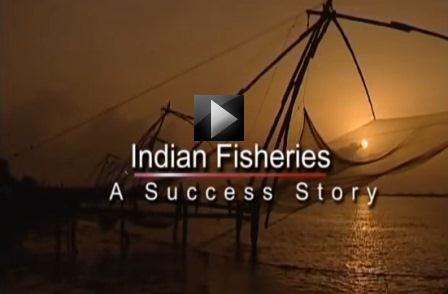Marine fisheries in india
Marine fisheries in india
Status of marine fisheries in India
Fisheries is an important sector in India. Iit provides employment to millions of people and contributes to food security of the country. With a coastline of over 8,000 km, an Exclusive Economic Zone (EEZ) of over 2 million sq km, and with extensive freshwater resources, fisheries play a vital role. The gross value addition of the fisheries and aquaculture sector during 2016-17 was Rs. 1,33,492 Crores which is about 0.96% of the National Gross Value Added (GVA) and 5.37% to the agricultural GVA (2016-17). During the year 2017-18, the country has exported 13,77,244 tonnes fish and fisheries products worth Rs. 45106.89 crore (7.08 billion US $).
Presently India is the second largest fish producing and second largest aquaculture nation in the world after China. The total fish production during2017-18 (provisional) is registered at 12.61 million metric tonnes (MMT) with a contribution of 8.92 MMT from inland sector and 3.69 MMT from marine sector.
The marine fishery potential in the Indian waters have been estimated at 5.31 MMT constituting about 43.3% demersal, 49.5% pelagic and 4.3% oceanic groups.
Marine Fisheries contributes to food security and provides direct employment to over 1.5 mn fisher people besides others indirectly dependent on the sector. There are 3,432 marine fishing villages and 1,537 notified fish landing centres in 9 maritime states and 2 union territories.
According to the CMFRI Census 2010, the total marine fisherfolk population was about 4 million comprising in 864,550 families. Nearly 61% of the fishermen families were under BPL category. The average family size was 4.63 and the overall sex ratio was 928 females per 1000 males. The Indian coastline can be delineated into 22 zones, based on the ecosystem structure and functions. The Indian boat type ranges from the traditional catamarans, masula boats, plank-built boats, dug out canoes, machwas, dhonis to the present day motorized fibre-glass boats, mechanized trawlers and gillnetters. In the marine fisheries sector, there were 194,490 crafts in the fishery out of which 37% were mechanized, 37% were motorized and 26% were non-motorized. Out of a total of 167,957 crafts fully owned by fisherfolk 53% were non-motorized, 24% were motorized and 23% were mechanized. Among the mechanized crafts fully owned by fishermen, 29% were trawlers, 43% were gillnetters and 19% were dolnetters.
Market intelligence
Central Marine Fisheries Research Institute (CMFRI), an ICAR institute located in Cochin, Kerala has been conducting fishery survey along the Indian coast and estimating marine fish landings and effort expended. Gearwise, specieswise, quarterwise fish landing data from the year 1962 for each maritime state of the country are being populated periodically at the Data Centre of CMFRI. This unique collation of first hand data based on the FAO approved sampling design has been the backbone of many a scientific endeavour carried out by avid fish researchers across the country and other parts of the globe.
Having blazed an illustrious trail for more than six decades, CMFRI has initiated a new system of field information dispensation on a near real time basis. As the first phase of this effort, the raised landing figures and the landing centre price range of important resources of major fishing harbours of the country are being published here. The landing figures (in kg) indicate the quantity of selected resources which were brought to the respective harbours during a 24 hours period starting from 12:00 noon of the first calendar day to 12:00 noon of the subsequent day. These figures are updated at 1600 Hrs every working day on as and where available base.
Click here for details on 'Daily landings at major harbours in India'
Source: Central Marine Fisheries Research Institute (CMFRI) & International Collective in support of Fish Workers (ICSF)
Advisories from INCOIS
Indian National Centre for Ocean Information Services (INCOIS) is an autonomous body under the Ministry of Earth Sciences, Government of India. INCOIS has a data warehouse of ocean related real-time information gathered from various institutions in India, which are involved in Marine Data Collection, Ocean Observation and Ocean/Atmospheric sciences. It translates the data into deliverable products to a range of users - Fishing community, State Fishery Department Officers, Planning Commission, Ports and Harbours, Shipping Industry, Navy, Indian Coast Guard, NHO Central Pollution Control Board etc.
Following services related to marine fisheries are being provided by INCOIS
- Potential Fishing Zone (PFZ)
- Indian Ocean Forecast System (INDOFOS)
- Indian Ocean Observing System (INDOOS)
- Global Ocean Observing System in Indian Ocean (IOGOOS)
- Tsunami Early Warning System
Source: INCOIS website
Related resources
- Manual on simple repairs & maintenance of FRP boats (506KB)
- Insulated fish boxes- Types, Specifications and Usage (426KB)
- Ice Boxes- Add value to your fish catch (845KB)
A film on Indian Fisheries - Success story
Last Modified : 12/23/2020
This topic provides information related to steps t...
This topic provides about *99# Service- Innovative...
This topic explains about psychological human deve...
This topic provides information about Zero tillage...

